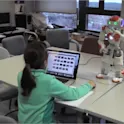Frontiers Communications
Editor
Editor

Health
10 Nov 2016
In a randomized double-blind trial, scientists show for the first time that dietary supplementation with daily dose of probiotic bacteria over a period of just 12 weeks is sufficient to yield a small but significant improvement in the cognitive performance of Alzheimer’s patients. For the first time, scientists have shown that probiotics — beneficial live bacteria and yeasts taken as dietary supplements — can improve cognitive function in humans. In a new clinical trial, scientists show that a daily dose of probiotic Lactobacillus and Bifidobacterium bacteria taken over a period of just 12 weeks is enough to yield a moderate but significant improvement in the score of elderly Alzheimer’s patients on the Mini-Mental State Examination (MMSE) scale, a standard measure of cognitive impairment. Probiotics are known to give partial protection against certain infectious diarrheas, irritable bowel syndrome, inflammatory bowel disease, eczema, allergies, colds, tooth decay, and periodontal disease. But scientists have long hypothesized that probiotics might also boost cognition, as there is continuous two-way communication between the intestinal microflora, the gastrointestinal tract, and the brain through the nervous system, the immune system, and hormones (along the so-called “microbiota-gut-brain axis”). In mice, probiotics have indeed been shown to improve learning and […]

Life sciences
10 Nov 2016
By Claudio Bogazzi, Frontiers Frontiers in Physics recently launched a new Research Topic, titled “The Physics associated with Neutrino Masses”. This topic was conceived by three physicists from different institutes: Dr. Aristizabal, Santa Maria University (Chile), Dr. Deppisch, University College of London (UK) and Dr. Merle, Max Planck Institute for Physics (Germany). The idea behind it is to provide a platform for broad discussion about phenomenological and theoretical aspects of neutrino masses and their implications. This topic focuses on one of the biggest challenges the physics community is currently facing. Neutrinos are subatomic particles with a mass so small and so hard to detect that even Wolfgang Pauli, the brilliant physicist who in the 1930s first postulated their existence, announced: “I have done a terrible thing, I have postulated a particle that cannot be detected”. To give you an idea, stop reading for just one second, and look at the palm of your hand. Did you notice anything? No? Well, you probably haven’t felt anything but about 1012 (a trillion!) neutrinos passed through your hand in that time. No wonder that Pauli was so pessimistic about their detection. Fortunately, Pauli was wrong. In 1955, two American physicists, Frederick Reines and Clyde […]

Health
08 Nov 2016
By Freya Wilson, Frontiers Science Writer Medical breakthrough could save babies before birth A recent breakthrough has been made that could help to save babies lives from a syndrome that threatens their survival even before they are born. Alpha Thalassemia Major is a blood disorder inherited from both parents and often results in the death of babies. However, a new possibility for treatment has been found that ensures not only their survival to birth but also curing the syndrome while still in the womb. “One therapy that we’re developing right now is stem-cell transplantation for fetuses that have congenital disorders that affect the blood cells,” said Dr. Tippi Mackenzie, an Associate Professor of Surgery at the University of California, San Francisco. Mackenzie lab’s recent research looks at a hereditary disease that affects the blood cells known as Alpha Thalassemia Major. This disorder is often incompatible with life and consequently must be identified in utero. “When fetuses have this disorder, they inherit it from both of their parents. The fetus becomes anaemic and can die,” MacKenzie explained. “Alpha Thalassemia major can be fatal to fetuses if they don’t get blood transfusions before birth. And in many cases, the only way to […]

Featured news
08 Nov 2016
Two major dependencies can be alleviated by increasing legume cultivation. These are the dependency of nitrogen fertilizers and the dependency on imports.

Neuroscience
04 Nov 2016
By Ian Salter, Frontiers Science Writer The use of robotic tutors in primary school classrooms is one step closer according to research recently published in the open access journal Frontiers in Computational Neuroscience. Dr Imbernòn Cuadrado and his co-workers at the Department of Artificial Intelligence in Madrid have developed an integrated computational architecture (ARTIE) for use with software applications in schools. “The main goal of our work was to design a system that can detect the emotional state of primary school children interacting with educational software and make pedagogic interventions with a robot tutor that can ultimately improve the learning experience,” says Luis Imbernòn Cuadrado. Online educational resources are becoming increasingly common in the classroom, although they have not taken into sufficient account that the learning ability of primary school children is particularly sensitive to their emotional state. This is perhaps where robot tutors can step in to assist teachers. Rather than focusing on specific emotions, the researchers first identified three cognitive states (concentrating, distracted and inactive) known to influence the course of learning. Keyboard strokes and mouse actions of children using educational software were used to predict which of these cognitive states the child is experiencing and subsequently linked […]

Humanities
04 Nov 2016
By Elliott Williams, Frontiers For forensic science, technology that assists in the analysis of complex and crucial evidence, such as DNA evidence, has seen rapid advancements, with ever more sensitive tests being introduced. Statistical interpretation of such complicated results has not been as swift. There exists now a lack of communication which spans all levels of those handling and presenting crucial evidence. Statisticians develop software with little input from the forensic scientist user, who does not have the possibility to discuss the intricacies of the results with the court. And in some cases, doesn’t know how the software “black box” generated its data. This is the long needed discussion Sue Pope (Principal Forensic Services) and Alex Biedermann (University of Lausanne) hope their topic, will spark between the statisticians developing analytical methods, the scientists who apply them, and the lawyers presenting the life changing results to the court. We spoke to them to find out more about this important and inter-disciplinary topic “The Dialogue Between Forensic Scientists, Statisticians and Lawyers about Complex Scientific Issues for Court.” Could you briefly give us some background on your Research Topic’s theme? As a working forensic scientist, I have become increasingly aware of the variety […]

Life sciences
03 Nov 2016
by Liam Drew, Frontiers Science Writer It was always thought that olfactory receptors’ sole bodily function was to smell, and could only be found inside a nose. But now a new study, published in Frontiers in Physiology, has found two olfactory receptors in human lung tissue. And when the researchers from Ruhr-University Bochum in Germany activated these receptors, they found that they regulated the way in which the airways smooth muscle cells contracted. Contraction of smooth muscle changes the size of our airways, suggesting that this research may open new avenues for treating chronic breathing disorders — such as asthma, emphysema and bronchitis — that constrict and obstruct the airways. No one had previously suspected that olfactory receptors would be present in airways past the nasal cavity. But working with human smooth muscle cells isolated and grown from the healthy parts of airway tissue surrounding excised tumors, Benjamin Kalbe and his colleagues applied a large number of odor molecules and watched two of them activate the muscle cells. Because it is well established which odors activate which receptors, Kalbe and team were able to probe tissue biopsies look for two specific receptors – OR1D2 and OR2AG1, finding found both of […]

Top news
03 Nov 2016
Frontiers was honored to be named a finalist in the 19th annual Ernst and Young (EY) Swiss Entrepreneur of the Year Awards. Since 1998, EY has offered a unique platform to celebrate entrepreneurs around the world, and this year was no exception. Frontiers was proud to be listed as one of three finalists in the category of Industry / High-Tech / Life Sciences. “It was an honor to have Frontiers recognized in this category for the EY Awards. The innovation landscape in Switzerland is of the highest caliber, and being a part of it is inspiring,” Kamila Markram, CEO and co-founder of Frontiers. “When we started Frontiers in 2007, it was about making science open and accessible to the world. Being recognised amongst these great innovators, reminds us of how far we have come with our mission – and how much farther we want to go.” Finalists had been vetted in several stages. First, only those who met the required criteria could be nominated to enter the competition. In an interview with EY, the nominees were then subject to a full review. An independent jury of renowned entrepreneurs used the facts and assessments from this process to select the finalists. Finally, the jury itself visited the potential winners and their premises to assesses the candidates’ and their […]

Frontiers news
01 Nov 2016
We are delighted to inform you that the University of Nottingham is in a pre-payment agreement with Frontiers. Eligible authors are required to complete the University’s Open Access Funding Form, to confirm funding, before obtaining the authorisation code. For more information and for a copy of the form please click here.

Life sciences
01 Nov 2016
Frontiers in Earth Science is excited to announce their first Twitter photo competition. Tweet @FrontEarthSci using #FEARTfieldpics with photos of your authorship showing your Earth Science field or lab work for a chance to win great prizes! We will display the best photos submitted by 30th November at our booth (1244) at the American Geophysical Union Fall Meeting in San Francisco, and will announce the winners of the photo competition on December 16th. The top photo will win wireless speakers, and the runners up will win solar chargers. Tweet us your photos using #FEARTfieldpics for a chance to win and to have your photo displayed on our booth at AGU!

Health
31 Oct 2016
By Hedwig Ens, Frontiers The impact of our dietary choices on the global phosphorus footprint shouldn’t be neglected, recent research in Frontiers in Nutrition shows. A shift towards a plant-based diet may be an undervalued solution toward decreasing our environmental impact and attaining phosphorus sustainability. Phosphorus is an element essential for all living beings and is thus critical in food production. Mined phosphate rock is a non-renewable global resource that is nowadays becoming increasingly scarce which poses a severe problem to the farming industry: it needs phosphorus in the form of fertilizers to sustain crop productivity. Crops have two entries into the human food chain: direct consumption or indirect consumption by rearing animals which can be converted to human food. Different food types therefore require different amounts of phosphorus in their production. One kg of phosphorus can for example be used to either produce 3333 kg of starch roots (e.g. potatoes) or 16 kg of beef. The loss of phosphorus to waterways, whether from agricultural fields through runoff or urban sewage through human excreta, can cause severe water quality degradation. This leads to eutrophication, harmful algal blooms, and impairment of our drinking water, recreational areas, and fisheries. As the […]

Life sciences
27 Oct 2016
By Ian Salter, Frontiers Science Writer If someone called you a shore crab, would you know what they mean? So synonymous are chameleons for their ability to rapidly change color that we use the word figuratively to describe a person who changes their opinion or behavior according to the situation. Although people are unlikely to refer to you as a shore crab, they may just as well as they form a group of more obscure species that have the ability to adaptively change their appearance. However, unlike Chameleons and cuttlefish, they are unable to do so over a matter of seconds. Rather these changes occur over hours to days, or sometimes even weeks. The benefits of comparatively slow color change are perhaps less obvious than instant camouflage or communication signals, but no less intriguing. In a recent article published in Frontiers in Ecology and Evolution, Prof. Martin Stevens of the University of Exeter explores these concepts in more detail. “Our goal is to understand the mechanisms and function of camouflage and how it works in terms of defeating predator vision,” explains Stevens. In addition to camouflage, other possible reasons for color change may include thermoregulation, signaling and protection from UV […]

Frontiers news
27 Oct 2016
Community Guidelines for comments and content The Frontiers blog is a place for researchers, media, industry and the general public to discuss science and scholarly issues in a respectful and intelligent way. Please keep your posts on topic and constructive. Above all, respect others and their opinions. All comments, blog posts and other content will be reviewed by Frontiers’ blog editorial team. Content that defames or attacks others will be removed. In addition, content that promotes products or services, or is not on topic will also be removed. Frontiers reserves the right to remove any content that we feel is abusive or not constructive. Repeat offenders may be blocked. If you have a specific complaint about a published research article or about a review process, we are happy to look into the matter. Please contact the editorial office editorial.office@frontiersin.org so that we may follow our standard procedures for formal complaints. REPUBLISHING GUIDELINES: At Frontiers, open-access and sharing research is part of our mission. Unless otherwise noted, you can republish our articles posted in the Frontiers blog – as long as you credit us with a link back. Editing the articles or selling them is not allowed. Want to contribute with a blog post? If you are […]

Engineering
26 Oct 2016
By Eva Brown, Frontiers Science Writer To help buildings become more resilient to earthquakes, scientists have taken measures to analyze various vibrational modes with the goal of creating safe and sustainable structures for future generations. Professor Izuru Takewaki and his team based at Kyoto University in Japan have centered their studies around the areas of earthquake engineering and the structural design of buildings. They are working towards grasping an understanding of how best to bring resilience in buildings — especially against natural disasters such as earthquakes. Their aim is to create safer and more sustainable constructions. “During Japan’s Tōhoku earthquake and Tsunami in 2011, many people were killed, so I’m working on developing safe designs of buildings,” Takewaki explains. “In my field we are looking at the worst case analysis as you don’t know when, where or how intense a disaster will be. We are also looking at the resilience of the buildings to withstand earthquakes.” In order to set the ground for progress, the team set out to measure the different vibrational states, which would enable them to develop safer building designs that are more stable and structurally secure. This, in turn, will enable the structures to withstand the […]

Neuroscience
26 Oct 2016
By Srividya Sundaresan, Science Writer Recent research shows brain-to-text device capable of decoding speech from brain signals Ever wonder what it would be like if a device could decode your thoughts into actual speech or written words? While this might enhance the capabilities of already existing speech interfaces with devices, it could be a potential game-changer for those with speech pathologies, and even more so for “locked-in” patients who lack any speech or motor function. “So instead of saying ‘Siri, what is the weather like today’ or ‘Ok Google, where can I go for lunch?’ I just imagine saying these things,” explains Christian Herff, author of a review recently published in the journal Frontiers in Human Neuroscience. While reading one’s thoughts might still belong to the realms of science fiction, scientists are already decoding speech from signals generated in our brains when we speak or listen to speech. In their review, Herff and co-author, Dr. Tanja Schultz, compare the pros and cons of using various brain imaging techniques to capture neural signals from the brain and then decode them to text. The technologies include functional MRI and near infrared imaging that can detect neural signals based on metabolic activity of […]
Get the latest research updates, subscribe to our newsletter